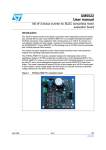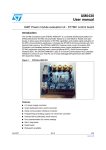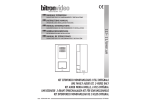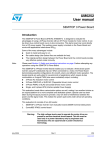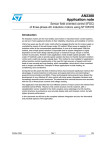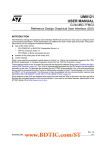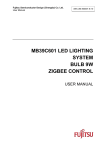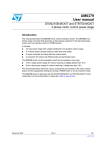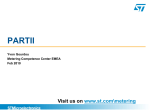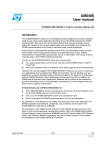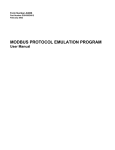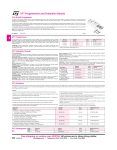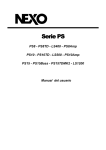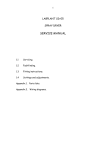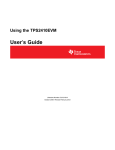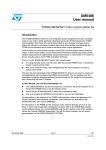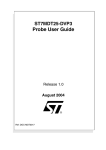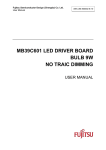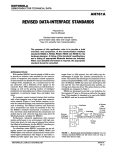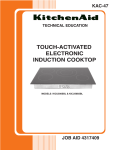Download Motor Drive Reference Design Kit
Transcript
UM0122 USER MANUAL Motor Drive Reference Design Kit INTRODUCTION The Motor Drive Reference Design Kit is comprised of three power boards that can be driven by a control board via six in-line connectors. The power boards can work directly from an AC or DC power supply (the PowerBD-3000 uses only DC power). The auxiliary power supply is located on the power boards and works with applications rated above 50VDC. Some of the many advantages include: – The kit is quick to set up and install, and is easy to run. – The design is re-usable (the Gerber files are available for free). – The original partition design between the power board and the control board provides very effective system noise immunity. Note: Please read the SAFETY AND OPERATING INSTRUCTIONS section before attempting any operation with this manual. The Motor Drive Reference Design Kit provides customers with a reference design for a three-phase power inverter using ST’s dedicated chip set. When they are connected to a motor, they allow the user to demonstrate smooth, silent, and efficient motor operation. The design boards are well-suited for several kinds of applications which required six-step commutation or 6-signal PWM (sine wave-modulated) output, including ■ 3PH AC Induction motor control, ■ 3PH PMDC/AC or BLDC/AC (Trapezoidal driven) motor control, ■ 3PH PMAC or BLAC (sinusoidal driven) motor control, and ■ Single- and 3-phase UPS (Uninterruptable Power Supply). This kit offers customization options as well, making it an excellent choice as an original platform for a more complete and dedicated system. Special care has been taken during the layout process to provide a very low level of interference between the Power and the Signal noise. This makes the system quite solid under almost all operating conditions. There are three (3) power boards for 3-phase inverters of different power rates and a control board: ■ PowerBD-300 (300W nominal rated power) ■ PowerBD-1000 (1000W nominal rated power) ■ PowerBD-3000 (3000W nominal rated power) ■ ControlBD-7FMC2 WARNING: The high voltage levels used to operate the motor drive could present a serious electrical shock hazard. This kit must be used only in a power laboratory only by engineers and technicians who are experienced in power electronics technology. Rev 2 March 2006 1/36 UM0122 - USER MANUAL TABLE OF CONTENTS INTRODUCTION . . . . . . . . . . . . . . . . . . . . . . . . . . . . . . . . . . . . . . . . . . . . . . . . . . . . . . . . . . . . . . . . . . . 1 SAFETY AND OPERATING INSTRUCTIONS . . . . . . . . . . . . . . . . . . . . . . . . . . . . . . . . . . . . . . . . . . . . 5 General . . . . . . . . . . . . . . . . . . . . . . . . . . . . . . . . . . . . . . . . . . . . . . . . . . . . . . Reference Design Board Intended Use . . . . . . . . . . . . . . . . . . . . . . . . . . . . Reference Design Board Installation. . . . . . . . . . . . . . . . . . . . . . . . . . . . . . Electronic Connection . . . . . . . . . . . . . . . . . . . . . . . . . . . . . . . . . . . . . . . . . Reference Design Board Operation. . . . . . . . . . . . . . . . . . . . . . . . . . . . . . . ...... ...... ...... ...... ...... ...... ...... ...... ...... ...... .....5 .....5 .....5 .....5 .....5 KIT-ACCESSIBLE ST7FMC2S4T6 MICROCONTROLLER FUNCTIONS . . . . . . . . . . . . . . . . . . . . . . . 6 Main Features . . . . . . . . . . . . . . . . . . . . . . . . . . . . . . . . . . . . . . . . . . . . . . . . . . . . . . . . . . . . . . . . . 6 Table 1. ST7FMC2S4T6 Functions . . . . . . . . . . . . . . . . . . . . . . . . . . . . . . . . . . . . . . . . . . . . . . . . . 6 DEMONSTRATION BOARD ELECTRICAL CHARACTERISTICS . . . . . . . . . . . . . . . . . . . . . . . . . . . . 8 Table 2. Power Board Electrical Characteristics . . . . . . . . . . . . . . . . . . . . . . . . . . . . . . . . . . . . . . . 8 Table 3. Control Board Electrical Characteristics . . . . . . . . . . . . . . . . . . . . . . . . . . . . . . . . . . . . . . 8 ELECTRICAL MOTOR CONTROL DEMONSTRATION SETUP . . . . . . . . . . . . . . . . . . . . . . . . . . . . . . 9 Environmental Considerations . . . . . . . . . . . . . . . . . . . . . . . . . . . . . . . . . . . . . . . . . . . . . . . . . . . 9 Power Board Connections . . . . . . . . . . . . . . . . . . . . . . . . . . . . . . . . . . . . . . . . . . . . . . . . . . . . . . 10 Table 4. Recommended Bulk Capacitor Values (typ) . . . . . . . . . . . . . . . . . . . . . . . . . . . . . . . . . . 10 Figure 1. PowerBD-300 Board Connections (Top View) . . . . . . . . . . . . . . . . . . . . . . . . . . . . . . . . 11 Figure 2. PowerBD-1000 Board Connections (Top View) . . . . . . . . . . . . . . . . . . . . . . . . . . . . . . . 11 Figure 3. PowerBD-3000 Board Connections (Top View) . . . . . . . . . . . . . . . . . . . . . . . . . . . . . . . 12 Figure 4. ControlBD-7FMC2 Board (Top View) . . . . . . . . . . . . . . . . . . . . . . . . . . . . . . . . . . . . . . . 12 Power Board Switches . . . . . . . . . . . . . . . . . . . . . . . . . . . . . . . . . . . . . . . . . . . . . . . . . . . . . . . . . 13 Setting up the Control Board . . . . . . . . . . . . . . . . . . . . . . . . . . . . . . . . . . . . . . . . . . . . . . . . . . . . 13 Figure 5. STGP14NC60KD Gate Resistor Turn OFF Voltage Slope . . . . . . . . . . . . . . . . . . . . . . . 13 Mandatory Checks Before Operation . . . . . . . . . . . . . . . . . . . . . . . . . . . . . . . . . . . . . . . . . . . . . 13 ControlBD-7FMC2 and 3PH AC INDUCTION MOTOR CONTROL SOFTWARE (Open Loop) v1.0 14 Download the Firmware into the ST7FMC Microcontroller . . . . . . . . . . . . . . . . . . . . . . . . Start-up Procedure . . . . . . . . . . . . . . . . . . . . . . . . . . . . . . . . . . . . . . . . . . . . . . . . . . . . . . . . Commands . . . . . . . . . . . . . . . . . . . . . . . . . . . . . . . . . . . . . . . . . . . . . . . . . . . . . . . . . . . . . . . Motor Direction . . . . . . . . . . . . . . . . . . . . . . . . . . . . . . . . . . . . . . . . . . . . . . . . . . . . . . . . . . . Potentiometer Commands . . . . . . . . . . . . . . . . . . . . . . . . . . . . . . . . . . . . . . . . . . . . . . . . . . . . . . 14 . . . . 14 . . . . 15 . . . . 15 . . . . 15 ControlBD-7FMC2 and 3PH AC INDUCTION MOTOR CONTROL SOFTWARE (Closed Loop) v1.016 Download the Firmware into the ST7FMC Memory . . . . . Start-up Procedure . . . . . . . . . . . . . . . . . . . . . . . . . . . . . . . Commands . . . . . . . . . . . . . . . . . . . . . . . . . . . . . . . . . . . . . . Motor Direction . . . . . . . . . . . . . . . . . . . . . . . . . . . . . . . . . . Potentiometer Commands . . . . . . . . . . . . . . . . . . . . . . . . . 2/36 ...... ...... ...... ...... ...... ....... ....... ....... ....... ....... ...... ...... ...... ...... ...... ...... ...... ...... ...... ...... . . . . 16 . . . . 16 . . . . 17 . . . . 17 . . . . 17 UM0122 - USER MANUAL ControlBD-7FMC2 and 3PH PMDC/AC or BLDC/AC (TRAPEZOIDAL DRIVEN) MOTOR CONTROL SOFTWARE (Open Loop) v1.0 . . . . . . . . . . . . . . . . . . . . . . . . . . . . . . . . . . . . . . . . . . . . . . . . . . . . . . 18 Download the Firmware into the ST7FMC Microcontroller . . . . . . . . . . . . . . . . . . . . . . . . Start-up Procedure . . . . . . . . . . . . . . . . . . . . . . . . . . . . . . . . . . . . . . . . . . . . . . . . . . . . . . . . Commands . . . . . . . . . . . . . . . . . . . . . . . . . . . . . . . . . . . . . . . . . . . . . . . . . . . . . . . . . . . . . . . Motor Direction . . . . . . . . . . . . . . . . . . . . . . . . . . . . . . . . . . . . . . . . . . . . . . . . . . . . . . . . . . . . . . . 18 . . . . 18 . . . . 18 . . . . 18 ControlBD-7FMC2 and 3PH PMDC/AC or BLDC/AC (TRAPEZOIDAL DRIVEN) MOTOR CONTROL SOFTWARE (Closed Loop) v1.0 . . . . . . . . . . . . . . . . . . . . . . . . . . . . . . . . . . . . . . . . . . . . . . . . . . . . . 19 Download the Firmware into the ST7FMC Memory . . . . . Start-up Procedure . . . . . . . . . . . . . . . . . . . . . . . . . . . . . . . Commands . . . . . . . . . . . . . . . . . . . . . . . . . . . . . . . . . . . . . . Motor Direction . . . . . . . . . . . . . . . . . . . . . . . . . . . . . . . . . . ...... ...... ...... ...... ....... ....... ....... ....... ...... ...... ...... ...... ...... ...... ...... ...... . . . . 19 . . . . 19 . . . . 19 . . . . 19 ControlBD-7FMC2 and 3PH PMAC or BLAC (SINUSOIDAL DRIVEN) MOTOR CONTROL SOFTWARE (Open Loop) v1.0 . . . . . . . . . . . . . . . . . . . . . . . . . . . . . . . . . . . . . . . . . . . . . . . . . . . . . . . . . . . 20 Hardware Modifications . . . . . . . . . . . . . . . . . . . . . . . . . . . . . . . . . . . . . . . . . . . . . . . . . . . . Download the Firmware into the ST7FMC Microcontroller . . . . . . . . . . . . . . . . . . . . . . . . Start-up Procedure . . . . . . . . . . . . . . . . . . . . . . . . . . . . . . . . . . . . . . . . . . . . . . . . . . . . . . . . Commands . . . . . . . . . . . . . . . . . . . . . . . . . . . . . . . . . . . . . . . . . . . . . . . . . . . . . . . . . . . . . . . Motor Direction . . . . . . . . . . . . . . . . . . . . . . . . . . . . . . . . . . . . . . . . . . . . . . . . . . . . . . . . . . . Potentiometer Commands . . . . . . . . . . . . . . . . . . . . . . . . . . . . . . . . . . . . . . . . . . . . . . . . . . . . . . 20 . . . . 20 . . . . 20 . . . . 21 . . . . 21 . . . . 21 ControlBD-7FMC2 and 3PH PMAC or BLAC (SINUSOIDAL DRIVEN) MOTOR CONTROL SOFTWARE (Closed Loop) v1.0 . . . . . . . . . . . . . . . . . . . . . . . . . . . . . . . . . . . . . . . . . . . . . . . . . . . . . . . . . . 22 Hardware Modifications . . . . . . . . . . . . . . . . . . . . . . . . . . . Download the Firmware into the ST7FMC Memory . . . . . Start-up Procedure . . . . . . . . . . . . . . . . . . . . . . . . . . . . . . . Commands . . . . . . . . . . . . . . . . . . . . . . . . . . . . . . . . . . . . . . Motor Direction . . . . . . . . . . . . . . . . . . . . . . . . . . . . . . . . . . Potentiometer Commands . . . . . . . . . . . . . . . . . . . . . . . . . ...... ...... ...... ...... ...... ...... ....... ....... ....... ....... ....... ....... ...... ...... ...... ...... ...... ...... ...... ...... ...... ...... ...... ...... . . . . 22 . . . . 22 . . . . 22 . . . . 23 . . . . 23 . . . . 23 APPENDIX A.PowerBD-300 CHARACTERISTICS AND SCHEMATIC . . . . . . . . . . . . . . . . . . . . . . . 24 Front-end . . . . . . . . . . . . . . . . . . . . . . . . . . Auxiliary Power Supply. . . . . . . . . . . . . . . Power Stage . . . . . . . . . . . . . . . . . . . . . . . . Figure 6. PowerBD-300 Schematic. . . . . . . ...... ...... ...... ...... ....... ....... ....... ....... ...... ...... ...... ...... ....... ....... ....... ....... ...... ...... ...... ...... ...... ...... ...... ...... . . . . 24 . . . . 24 . . . . 25 . . . . 26 APPENDIX B.PowerBD-1000 CHARACTERISTICS AND SCHEMATIC . . . . . . . . . . . . . . . . . . . . . . 27 Front-end . . . . . . . . . . . . . . . . . . . . . . . . . . Auxiliary Supply . . . . . . . . . . . . . . . . . . . . Power Stage . . . . . . . . . . . . . . . . . . . . . . . . Figure 7. PowerBD-1000 Schematic. . . . . . ...................................... ...................................... ...................................... ...................................... . . . . 27 . . . . 27 . . . . 28 . . . . 29 APPENDIX C.PowerBD-3000 CHARACTERISTICS AND SCHEMATIC . . . . . . . . . . . . . . . . . . . . . . 30 3/36 UM0122 - USER MANUAL Front-end . . . . . . . . . . . . . . . . . . . . . . . . . . Auxiliary Supply . . . . . . . . . . . . . . . . . . . . Power Stage . . . . . . . . . . . . . . . . . . . . . . . . Figure 8. PowerBD-3000 Schematic. . . . . . ...................................... ...................................... ...................................... ...................................... . . . . 30 . . . . 30 . . . . 31 . . . . 32 APPENDIX D.ControlBD-7FMC2 CHARACTERISTICS AND SCHEMATIC. . . . . . . . . . . . . . . . . . . . 33 Gate Drive Circuit . . . . . . . . . . . . . . . . . . . . . . . . . . . . . . . . . . . . . . . . . . . . . . . . . . . . . . . . . . . . . 33 Microcontroller User Interfaces . . . . . . . . . . . . . . . . . . . . . . . . . . . . . . . . . . . . . . . . . . . . . . . . . . 33 Figure 9. ControlBD-7FMC2 Schematic . . . . . . . . . . . . . . . . . . . . . . . . . . . . . . . . . . . . . . . . . . . . . 34 REVISION HISTORY. . . . . . . . . . . . . . . . . . . . . . . . . . . . . . . . . . . . . . . . . . . . . . . . . . . . . . . . . . . . . . . 35 Table 5. Document Revision History . . . . . . . . . . . . . . . . . . . . . . . . . . . . . . . . . . . . . . . . . . . . . . . 35 4/36 UM0122 - USER MANUAL SAFETY AND OPERATING INSTRUCTIONS General During assembly and operation, the Motor Drive Reference Design Kit poses several inherent hazards, including bare wires, moving or rotating parts, and hot surfaces. There is danger of serious personal injury and damage to property, if the Kit or its components are improperly used or installed incorrectly. All operations involving transportation, installation and use, as well as maintenance are to be carried out by skilled technical personnel (national accident prevention rules must be observed). For the purposes of these basic safety instructions, “skilled technical personnel” are suitably qualified people who are familiar with the installation, use, and maintenance of power electronic systems. Reference Design Board Intended Use The Motor Drive Reference Design boards are components designed for demonstration purposes only, and shall not be used for electrical installation or machinery. The technical data as well as information concerning the power supply conditions shall be taken from the documentation and strictly observed. Reference Design Board Installation The installation and cooling of the Reference Design boards shall be in accordance with the specifications and the targeted application (see ELECTRICAL MOTOR CONTROL DEMONSTRATION SETUP, page 9). – The motor drive converters shall be protected against excessive strain. In particular, no components are to be bent, or isolating distances altered during the course of transportation or handling. – No contact shall be made with electronic components and contacts. – The boards contain electrostatically sensitive components that are prone to damage through improper use. Electrical components must not be mechanically damaged or destroyed (to avoid potential health risks). Electronic Connection Applicable national accident prevention rules must be followed when working on the main power supply with a motor drive. The electrical installation shall be completed in accordance with the appropriate requirements (e.g., cross-sectional areas of conductors, fusing, PE connections; for further information, see ELECTRICAL MOTOR CONTROL DEMONSTRATION SETUP, page 9). Reference Design Board Operation A system architecture which supplies power to the Reference Design Boards shall be equipped with additional control and protective devices in accordance with the applicable safety requirements (e.g., compliance with technical equipment and accident prevention rules). Note: Do not touch the Design Boards after disconnection from the voltage supply, as several parts and power terminals which contain possibly energized capacitors need to be allowed to discharge. 5/36 UM0122 - USER MANUAL KIT-ACCESSIBLE ST7FMC2S4T6 MICROCONTROLLER FUNCTIONS Main Features ■ ■ ■ ■ ■ ■ ■ TQFP44 package 16K dual voltage FLASH program memory with read-out protection capability 768 bytes RAM Low voltage supervisor with: – clock security system – nested interrupt controller with 14 interrupt vectors – two 16-bit timers – one 8-bit auto-reload timer Serial Peripheral Interface (SPI) Local Interconnect Network Serial Communication Interface (LINSCI™) Motor Controller (MTC) peripheral with: – 6 high sink Pulse Width Modulator (PWM) output channels – asynchronous Emergency Stop – 4 analog inputs for rotor position detection – Op Amp and Comparator for current limitation – 10-bit Analog-to-Digital Converter (ADC) with 11 inputs – In-circuit Communication Interface (ICC, debug) Table 1. ST7FMC2S4T6 Functions Function I/O Name MCO0 to MCO5 MCIA, MCIB, MCIC MTC SPI LINSCI™ 6/36 Description (depends on embedded software) PWM outputs Analog or Digital input for position sensor or B.E.M.F. detection MCVREF B.E.M.F. Detection Comparator reference NMCES Emergency Stop MCAOP Operational Amplifier Positive Input MCAON Operational Amplifier Negative Input MCAOZ Operational Amplifier Output MCCREF Current Limitation reference MCPWMU PWM Output U MCPWMV PWM Output V MCPWMW PWM Output W MISO Master In/Slave Out data MOSI Master Out/Slave In data SCK Serial Clock RDI Received Data Input TDO Transmit Data Output UM0122 - USER MANUAL Function I/O Name Description (depends on embedded software) AIN0 Temperature sensor input AIN1 Line voltage sensing input AIN7 Trimmer reading input AIN11 Trimmer reading input AIN12 Trimmer reading input AIN13 A/D input 10-bit ADC ICC ICCCLK Output Serial Clock ICCDATA Input/Output Serial Data ICCSEL/Vpp Programming Voltage Input PB7 PE0/OCMP2 Others PE1/OCMP1 High Sink LED Output PE2/ICAP2 PE3/ICAP1 High Sink I/O or Timer B Output Compare 2 I/O or Timer B Output Compare 1 I/O or Timer B Input Capture 2 I/O or Timer B Input Capture 1 7/36 UM0122 - USER MANUAL DEMONSTRATION BOARD ELECTRICAL CHARACTERISTICS Table 2. Power Board Electrical Characteristics PowerBD-300 PowerBD-1000 PowerBD-3000 Min Max Min Max Min Max Range with on-board auxiliary supply and double rectification 50 260 50 260 50 260 V Range with on-board auxiliary supply and voltage doubler 25 135 25 135 25 135 V Range with on-board auxiliary supply 70 370 70 370 70 370 V 14 15 14 15 14 15 V Power Board Parameters Unit AC Input Voltage DC Input Voltage External Auxiliary Supply Source Current Consumption in Idle State 30 50 40 mA Recommended Power Switches 12VDC Input Voltage STB100NF04T4 STB150NF04T4 N/A N/A 24VDC Input Voltage STB60NF06T4 STB80NF5508T4 N/A N/A 42VDC Input Voltage STB30NF10T4 STB75NF75T4 N/A N/A 120VAC (with Voltage Doubler) or 230VAC Input Voltage STGB6NC60HD STGF10NC60KD STGP14NC60KD STGW20NC60VD Note: NA = Not Applicable Table 3. Control Board Electrical Characteristics ControlBD-7FMC2 Control Board Parameters Unit Min Max 15V Auxiliary Supply range 14 15 V 5V Auxiliary Supply range 4.5 5.5 V J6 Driving Current capability BEMF Input Current capability 15V Bias Current (typ) 5V Bias Current (typ) T1, T2 Input Voltage capability 8/36 UM0122 - USER MANUAL ELECTRICAL MOTOR CONTROL DEMONSTRATION SETUP Most of the system features are covered in this user manual, starting from the main power supply frontend to the power stages, including the operation of the +5V/+15V power supply and microcontroller. This kit includes the following key components: ■ Motor control-dedicated microcontrollers ■ L6386 half-bridge drivers ■ 60V MOSFET or 600V Insulated Gate Bipolar Transistor (IGBT) ■ VIPer12 auxiliary supply smart power switch ■ Small-Signal Bipolar Transistors ■ STTH108 and BAS70W Diodes ■ 78L05 voltage regulator ■ M95040 EEPROM memory ■ P6KE400A and 1.5KE400A Transil™ diodes (optional) WARNING: The starter kit has no isolation shield or any other type of protection case. The demonstration board must be handled very carefully, as high potential (energy) parts are open and can be touched. The user MUST avoid connecting or removing cables during operation of an electric motor, or touching any part of the system when it is connected to the main power supply. Note: After turning the motor off, the DC-link capacitor may still hold voltage for several minutes (refer to the LEDs on the control board - Figure 9., page 34). Note: Do NOT expose the kits to ambient temperatures of over 35°C, as this may harm the components or reduce their lifetimes. For more information on the demonstration software and libraries, refer to Application Notes AN1291, AN1083, and AN1276. Environmental Considerations The Motor Drive Reference Design Kit must only be used in a power laboratory. The high voltage used in any AC drive system presents a serious shock hazard. A complete laboratory setup consists of an isolated AC power supply, the Reference Design Kit, an AC Induction motor, and isolated (laboratory) power supplies for +15V (as needed). The Kit is not electrically isolated from the AC input. This topology is very common in AC drives. The microprocessor is grounded by the integrated Ground of the DC bus. The microprocessor and associated circuitry are hot and MUST be isolated from user controls and serial interfaces. Note: Any measurement equipment must be isolated from the main power supply before powering up the motor drive. To use an oscilloscope with the Kit, it is safer to isolate the AC supply AND the oscilloscope. This prevents a shock occurring as a result of touching any SINGLE point in the circuit, but does NOT prevent shocks when touching TWO or MORE points in the circuit. An isolated AC power supply can be constructed using an isolation transformer and a variable transformer. A schematic of this AC power supply is in the Application Note, “AN438, TRIAC + Microcontroller: Safety Precautions for Development Tools.” (Although this Application Note was written for TRIAC, the isolation constraints still apply for fast switching semiconductor devices such as IGBTs.) Note: Isolating the application rather than the oscilloscope is highly recommended in any case. 9/36 UM0122 - USER MANUAL Power Board Connections Note: Before supplying power to the boards, verify the connection integrity and make sure there are no unintended earth/ground loops caused by peripheral (e.g., test) equipment (e.g., PC or oscilloscope). ■ Cables Choose the appropriate gauge wiring for the motor’s current ratings. Note: Electrostatic charges may accumulate on a floating motor and increased voltage may be present due to energized capacitors which need to be allowed to discharge. ■ ■ Straps and Jumpers Several jumpers allow the two bulk capacitors to function in serial (current with one path to follow) or parallel (current with at least two paths to follow) configuration: – Three jumpers allow for operation with Double Rectification. This is enabled by soldering jumpers J1-J3, J9-J10, and J4-J5, and keeping J12-J13 open (see Figure 6., page 26, Figure 7., page 29, and Figure 8., page 32). This configuration is recommended when the main power supply voltage ranges from 180VAC to 260VAC. – Three jumpers enable the Voltage Doubler. This is enabled by soldering jumpers J1-J6, J7-J11, and J12-J13, and keeping J4-J5 open (see Figure 6., Figure 7., and Figure 8.). This configuration is recommended when the main power supply stays below 130VAC. This will double the main power supply voltage and, consequently, the output voltage available to the motor. For example, a main power supply voltage of 120VAC will produce a bus voltage of about 320VDC. This higher output voltage allows the motor to draw less current. Note: Care must be taken when operating the motor in this mode. Input voltage must be kept below 135VACRMS. If this value is exceeded for any reason, the bulk capacitors will be protected by the optional Transil™ diode TR1 (P6KE400A D0-15 or 1.5KE400A D0-201; see Figure 6., Figure 7., and Figure 8.). It will clamp to the high voltage DC bus, causing the input protection fuse to blow. Bulk Capacitor Jumpers – AC Input AC Input bulk capacitors must be installed according to the line voltage and power ratings BEFORE plugging in the board. – DC Input DC Input bulk capacitors must be installed according to the supply line inductance and soft-start conditions BEFORE plugging in the board. Table 4. Recommended Bulk Capacitor Values (typ) AC Input 10/36 DC Input Capacitance (µF/100W) Input Voltage (VAC) Capacitance (µF/100W) Line Voltage (VDC) 47 230 4700 12 220 120 2200 24 1000 48 1000 44 UM0122 - USER MANUAL Figure 1. PowerBD-300 Board Connections (Top View) +VDC AC Input 15V Power Supply BEMF and Hall Effect Sensors –VDC Tachometer Input Motor Output Figure 2. PowerBD-1000 Board Connections (Top View) Motor Output Tachometer Input +VDC AC Input –VDC BEMF and Hall Effect Sensors 15V Power Supply 11/36 UM0122 - USER MANUAL Figure 3. PowerBD-3000 Board Connections (Top View) Breaking Resistors Motor Output Tachometer Input BEMF and Hall Effect Sensors 15V Power Supply +VDC –VDC Figure 4. ControlBD-7FMC2 Board (Top View) ICC Connector: HE10 male type 12/36 S2 SW Push-button S1 SW DIP-2 Potentiometers P1, P2, P3 LEDs UM0122 - USER MANUAL Power Board Switches Table 2., page 8 lists the appropriate power switches which must be installed on the power board. The packaging with the “FP” suffix are fully insulated by molding, and do not require any external insulators. The D2 packages are insulated from each other by the PC board (PCB). Note: Care must be taken to ensure TO220, TO247, and MAXTO247 are NOT insulated. They require external insulator pads (i.e., polyimide foil between the heat sink and power switches). Setting up the Control Board The gate drive resistor value is 100Ω. This must be adjusted according to the power switch gate capacitance and the expected switching dV/dt. Figure 5. allows the user to determine the correct value, depending on the maximum dV/dt specified for the motor. Note: The L6386 High Voltage High and Low Side Driver requires a power supply voltage of 15VDC (typ). If the motor operation requires less than 14VDC, the L6387 is preferred because the operation supply voltage range goes down to 6VDC. Figure 5. STGP14NC60KD Gate Resistor Turn OFF Voltage Slope 9 8 dV/dt (V/ns) 7 6 5 4 3 0 20 40 60 RG (Ω) 80 100 120 AI11102 Note: Conditions: VCC = 390V, VGE = 15V, ICC = 7A, TJ = 125°C Mandatory Checks Before Operation The following verifications must be performed before operating the Demonstration Board: – jumpers are correctly configured, – the motor is connected and earth-grounded, – a control board with validated software is plugged into the power board, – there is no metal part on, below, or around the PC boards, and there are no unintended earth/ground loops caused by peripheral (e.g., test) equipment (e.g., PC or oscilloscope), and – the motor and mechanical load are safely housed so that rotating parts cannot be inadvertently accessed and cause injury (e.g., loose clothing, long hair). 13/36 UM0122 - USER MANUAL ControlBD-7FMC2 and 3PH AC INDUCTION MOTOR CONTROL SOFTWARE (Open Loop) v1.0 The software operates the ControlBD-7FMC2 board in a standalone manner, with the operation controlled by the Push-button S2 and the on-board trimmer potentiometers (P2, P3). S2 controls ON/OFF function, P2 sets the voltage, and P3 sets the frequency. Download the Firmware into the ST7FMC Microcontroller For configuring the ControlBD-7FMC2 as 3PH AC Induction motor controller, it is necessary to download the proper binary source code (.S19 file) into the microcontroller. For open loop operations, the binary file provided with AC software library can be downloaded into the ST7FMC code memory as it is. This can be done with the Datablaze Programmer utility. Please refer to User Manual UM0121, “ControlBD-7FMC2 Reference Design Graphical User Interface (GUI)” for details. The settings provided for this binary code can be viewed in the “Basic Parameter” window of the Reference Design RDK-GUI tool when the “3 PH AC Induction” motor option has been selected. Start-up Procedure 1. Connect a 3 phase induction motor (mechanically unloaded) to connectors FST4, FST6, and FST7. Sequencing is arbitrary and the direction of rotation will be set later. 2. Remove the control board jumpers J11 and J12, and set jumper J10 between 1-2. 3. Set all potentiometers (P2 and P3) to full Counter Clockwise (CCW) position. Potentiometer P3 is the FREQUENCY setting. Full CCW to full Clockwise (CW) corresponds to a range of 10Hz to 340Hz, with increments of 1Hz. 4. Monitor one of the three motor currents with an isolated current probe. 5. Apply the main voltage supply to connectors FST3 and FST5, or a DC voltage supply to connectors FST1 (+) and FST2 (–). Note: In the Idle state, a green LED will be flashing, and then it will stay on. 6. Set P3 to about 60Hz (1/4 turn CW). 7. Switch ON S2. Note: In the Run state, the red LED will light up. The motor current should remain at zero, although some switching noise may be observed. 8. Slowly rotate potentiometer P2 CW to begin increasing the Voltage setting from zero. You should start to see a 60Hz (approximately) current build-up in the motor and then the motor should begin to rotate. 9. Continue to increase the setting until the motor has come up to the expected speed for this excitation frequency. Keep in mind that some slip will be expected. The current waveform should remain fairly sinusoidal. If the waveform becomes highly distorted or exceeds the motor rating, decrease the Voltage setting. WARNING: The entire circuit board and motor output terminals are always “hot” with respect to earth ground, even when the drive is in a stopped condition. 14/36 UM0122 - USER MANUAL Commands If the S2 button is pushed, it starts the motor. When the drive is running and the S2 button is pushed, it stops the motor. The controller always enforces a maximum slew limit on changes to the frequency of excitation applied to the motor. In practice this softens the motion of the motor, causing it to ramp up to the commanded frequency (speed) when going from STOP to RUN. Decreasing the frequency and voltage applied to the motor slowly decreases the speed (to zero). Note: It is acceptable to start or stop the drive at any time and speed because of the slew limit. Motor Direction If you wish to change the running direction of the motor, simply disconnect the drive from the main voltage supply, wait for the bulk capacitors to discharge, then swap any two of the three motor wires. Potentiometer Commands P2. Sets the Voltage applied from the minimum value (0) to the maximum VBUS. This setting is internally limited with a V/F curve (refer to User Manual UM0121). P3. Sets the motor frequency and thus the motor speed. Use P3 to set the stator frequency as well. The contribution of P3 is 10Hz when it is in the maximum CCW position and will increment downward by 1Hz resolution to reach 340Hz by rotating the potentiometer to full CW position. Note: For configuration of the software library with the RDK-GUI, see User Manual UM0121. 15/36 UM0122 - USER MANUAL ControlBD-7FMC2 and 3PH AC INDUCTION MOTOR CONTROL SOFTWARE (Closed Loop) v1.0 The software operates the ControlBD-7FMC2 board in a standalone manner, with the operation controlled by the Push-button S2 and the on-board trimmer potentiometer (P3). S2 controls ON/OFF function and P3 sets the target rotor frequency from 10 to 340Hz (for one pole pair motor). Download the Firmware into the ST7FMC Memory For configuring the ControlBD-7FMC2 as a “3PH AC Induction” motor controller, it is necessary to download the proper binary source code into the MCU flash memory. Unlike the “Open Loop” operation, a new “.S19” binary file must be generated using the RDK-GUI PC software tool provided with the companion CD-ROM. Please refer to User Manual “UM0121, ControlBD7FMC2 Reference Design Graphical User Interface (GUI)” for details. Start-up Procedure 1. Connect a 3 phase induction motor (mechanically unloaded) to connectors FST4, FST6, and FST7. Sequencing is arbitrary and the direction of rotation will be set later. 2. Remove the control board jumpers J11 and J12, and set jumper J10 between 1-2. 3. Connect the two tachogenerator terminals into connectors FST8 and FST9. 4. Set the pot (P3) to full CCW position. Potentiometer P3 is the target rotor FREQUENCY setting. Full CCW to full CW corresponds to a range of 10Hz to 340Hz (for one pole pairs motor), with increments of 1Hz. 5. Monitor one of the three motor currents with an isolated current probe. 6. Apply the main voltage supply to connectors FST3 and FST5, or a DC voltage supply to connectors FST1 (+) and FST2 (–). Note: In the Idle state, a green LED will be flashing, and then it will stay on. 7. Set P3 to about 60Hz (1/4 turn CW). 8. Switch ON S2. Note: In the Run state, the red LED will light up. The motor current should remain at zero, although some switching noise may be observed. The motor should reach the target rotor frequency set by P3. The current waveform should remain fairly sinusoidal. If the waveform becomes highly distorted or exceeds the motor rating, modify the V/ F curve (refer to User Manual UM0121). WARNING: The entire circuit board and motor output terminals are always “hot” with respect to earth ground, even when the drive is in a stopped condition. 16/36 UM0122 - USER MANUAL Commands If the S2 button is pushed, it starts the motor. When the drive is running and the S2 button is pushed, it stops the motor. The controller always enforces a maximum slew limit on changes to the frequency of excitation applied to the motor. In practice this softens the motion of the motor, causing it to ramp up to the commanded frequency (speed) when going from STOP to RUN. Decreasing the frequency and voltage applied to the motor slowly decreases the speed (to zero). Note: It is acceptable to start or stop the drive at any time and speed because of the slew limit. Motor Direction If you wish to change the running direction of the motor, simply disconnect the drive from the main voltage supply, wait for the bulk capacitors to discharge, then swap any two of the three motor wires. Potentiometer Commands P3. Sets the rotor target frequency and thus the motor speed. The contribution of P3 is 10Hz when it is in the maximum CCW position and will increment downward by 1Hz resolution to reach 340Hz (for one pole pair motor) by rotating the potentiometer to full CW position. Note: For configuration of the software library with the RDK-GUI, see User Manual UM0121. 17/36 UM0122 - USER MANUAL ControlBD-7FMC2 and 3PH PMDC/AC or BLDC/AC (TRAPEZOIDAL DRIVEN) MOTOR CONTROL SOFTWARE (Open Loop) v1.0 The software operates the ControlBD-7FMC2 board in a standalone manner, with the operation controlled by the Push-button S2 and the on-board trimmer potentiometer (P1). S2 controls the ON/OFF function. Download the Firmware into the ST7FMC Microcontroller For configuring the ControlBD-7FMC2 as a “3PH PMDC (trapezoidal)” motor controller, it is necessary to download the proper binary source code (.S19 file) into the microcontroller. For open loop operations, the binary file provided with PMDC software library can be downloaded into the ST7FMC code memory as it is. This can be done with the Datablaze Programmer utility. Please refer to User Manual UM0121, “ControlBD-7FMC2 Reference Design Graphical User Interface (GUI)” for details. The settings provided for this binary code can be viewed in the “Main” window of the RDK-GUI tool when the “3PH PMDC (Trapezoidal)” motor has been selected. Start-up Procedure 1. Connect a 3 phase BLDC motor (mechanically unloaded) to connectors FST4, FST6, and FST7. Sequencing is arbitrary and the direction of rotation will be set later. 2. Set the control board jumpers J10 between 2-3, J11, and J12 between 1-2. 3. Set the pot (P1) to a predetermined position (e.g., center). 4. Apply the main voltage supply to connectors FST3 and FST5, or a DC voltage supply to connectors FST1 (+) and FST2 (–). Note: In the Idle state, the green LED will light up. 5. Switch ON S2. Note: In the Run state, the red LED will stay on. The motor will be pulled into alignment position first, then it will start to turn. If the motor starts successfully, adjust P1 to change the motor speed. Note: When S2 is switched ON, the starting ramp-up will be executed until the BEMF is detected, and the motor is successfully started. Commands If the S2 button is pushed, it starts the motor. When the drive is running and the S2 button is pushed, it stops the motor. The potentiometer P1 sets the motor speed command. Since this is voltage mode, open loop control, it sets the PWM duty cycle from 0% to 97%. In order to sense the back EMF, the motor must first be started and brought up to a certain speed where the back EMF voltage (BEMF) can be detected. Before the motor is started, the controller will bring the rotor to a predetermined position. This is called the “alignment phase”. After the rotor is in the alignment position, a fixed accelerating commutation command will be invoked by the microcontroller. If the acceleration rate is correct, the motor will be accelerated until the microcontroller can detect the BEMF and switch to auto-switched mode. Note: When PowerBD-300 is used with high voltage, it is necessary to add a STTH108 diode in series with a 1K ¼Ω resistor, and connect it in parallel with the BEMF resistors as is done for the PowerBD-1000. Motor Direction If you wish to change the running direction of the motor, simply disconnect the drive from the main voltage supply, wait for the bulk capacitors to discharge, then swap any two of the three motor wires. Note: For configuration of the software library with the RDK-GUI, see User Manual UM0121. 18/36 UM0122 - USER MANUAL ControlBD-7FMC2 and 3PH PMDC/AC or BLDC/AC (TRAPEZOIDAL DRIVEN) MOTOR CONTROL SOFTWARE (Closed Loop) v1.0 The software operates the ControlBD-7FMC2 board in a standalone manner, with the operation controlled by the Push-button S2 and the on-board trimmer potentiometer (P1). S2 controls the ON/OFF function. Download the Firmware into the ST7FMC Memory For configuring the ControlBD-7FMC2 as a “3PH PMDC/AC or BLDC/AC (trapezoidal driven)” motor controller, it is necessary to download the proper binary source code into the MCU flash memory. Unlike the “Open Loop” operation, a new “.S19” binary file must be generated using the RDK-GUI PC software tool provided with the companion CD-ROM. Please refer to User Manual “UM0121, ControlBD7FMC2 Reference Design Graphical User Interface (GUI)” for details. Start-up Procedure 1. Connect a 3 phase induction motor (mechanically unloaded) to connectors FST4, FST6, and FST7. Sequencing is arbitrary and the direction of rotation will be set later. 2. Set the control board jumpers J10 between 2-3, J11, and J12 between 1-2. 3. Set the pot (P1) to a predetermined position (e.g., center). 4. Apply the main voltage supply to connectors FST3 and FST5, or a DC voltage supply to connectors FST1 (+) and FST2 (–). Note: In the Idle state, the green LED will light up. 5. Switch ON S2. Note: In the Run state, the red LED will stay on. The motor will be pulled into alignment position first, then it will start to turn. If the motor starts successfully, adjust P1 to change the motor speed. Note: When S2 is switched ON, the starting ramp-up will be executed until the BEMF is detected, and the motor is successfully started. Commands If the S2 button is pushed, it starts the motor. When the drive is running and the S2 button is pushed, it stops the motor. The potentiometer P1 sets the motor target frequency speed command, and sets the rotor frequency from 50Hz to 200Hz (for two pole pairs motor). In order to sense the back EMF, the motor must first be started and brought up to a certain speed where the back EMF voltage (BEMF) can be detected. Before the motor is started, the controller will bring the rotor to a predetermined position. This is called the “alignment phase”. After the rotor is in the alignment position, a fixed accelerating commutation command will be invoked by the microcontroller. If the acceleration rate is correct, the motor will be accelerated until the microcontroller can detect the BEMF and switch to auto-switched mode. Note: When PowerBD-300 is used with high voltage, it is necessary to add a STTH108 diode in series with a 1K ¼Ω resistor, and connect it in parallel with the BEMF resistors as is done for the PowerBD-1000. Motor Direction If you wish to change the running direction of the motor, simply disconnect the drive from the main voltage supply, wait for the bulk capacitors to discharge, then swap any two of the three motor wires. Note: For configuration of the software library with the RDK-GUI, see User Manual UM0121. 19/36 UM0122 - USER MANUAL ControlBD-7FMC2 and 3PH PMAC or BLAC (SINUSOIDAL DRIVEN) MOTOR CONTROL SOFTWARE (Open Loop) v1.0 Hardware Modifications – To use the PowerBD-300 to drive a PMAC sensor motor, the user needs to remove the R8, R11, and R13 resistors and mount the (4.7kΩ) R14, R15, and R16 resistors. – To use the PowerBD-1000 to drive a PMAC sensor motor, the user needs to remove the R27, R28, R29, R12, R15, and R17 resistors and mount the (4.7kΩ) R19, R20, and R21 resistors. – To use the PowerBD-3000 to drive a PMAC sensor motor, the user needs to remove R30, R31, R32, R12, R15, and R17 resistors and mount the (4.7kΩ) R19, R20, and R21 resistors. Note: In each of these cases, the ControlBD-7FMC2 needs to have the (10nF) C22, C23, and C24 capacitors mounted on it. The software operates the ControlBD-7FMC2 board in a standalone manner, with the operation controlled by the Push-button S2 and the on-board trimmer potentiometers (P1 and P3). S2 controls the ON/OFF function, P1 sets the voltage level index, and P3 can set the Phase Shift angle. Download the Firmware into the ST7FMC Microcontroller For configuring the ControlBD-7FMC2 as a “3PH PMAC (Sinusoidal)” motor controller, it is necessary to download the proper binary source code (.S19 file) into the microcontroller. For open loop operations, the binary file provided with PMAC software library can be downloaded into the ST7FMC code memory as it is. This can be done with the Datablaze Programmer utility. Please refer to User Manual UM0121, “ControlBD-7FMC2 Reference Design Graphical User Interface (GUI)” for details. The settings provided for this binary code can be viewed in the “Main” window of RDK-GUI tool when the “3PH PMAC (Sinusoidal)” motor has been selected. Start-up Procedure 1. Connect a 3 phase PMAC motor (mechanically unloaded) to connectors FST4, FST6, and FST7. Sequencing is arbitrary and the direction of rotation will be set later. 2. Connect at least 1 Hall sensor signal into pin1 of the CON1 connector of PowerBD-300, PowerBD1000, or PowerBD-3000. Note: The CON1 connector has the following pin connections: – PIN1: Hall sensor signal 1 – PIN2: Hall sensor signal 2 – PIN3: Hall sensor signal 3 – PIN4: +5 Volt – PIN5: GND 3. Connect the control board Jumpers J11 and J12, and set Jumper J10 between 2-3. 4. Set P1 between full CW position and full CCW position and P3 to full CCW position. 5. Monitor one of the three motor currents with an isolated current probe. 6. Apply the main voltage supply to connectors FST3 and FST5, or a DC voltage supply to connectors FST1 (+) and FST2 (–). Note: In the Idle state, the green LED will stay on. 7. Switch ON S2. Note: In the Run state, the red LED will light up. The motor could run poorly (e.g., discontinuous mode or oscillation) until the correct Phase Shift is set by P3. 20/36 UM0122 - USER MANUAL 8. Slowly rotate potentiometer P3 CW to find the correct Phase Shift. The correct value is reached when the user notices the motor running well (without discontinuity). Note: Make final adjustments to the Phase Shift by monitoring the current on the oscilloscope. The optimal Phase Shift normally minimizes the motor current amplitudes (see the Application Note AN1947 for more information). 9. Rotate P1 in the CW direction until the motor has come up to the expected speed for this excitation level. Note: The current waveforms should remain fairly sinusoidal. WARNING: The entire circuit board and motor output terminals are always “hot” with respect to earth ground, even when the drive is in a stopped condition. Commands If the S2 button is pushed, it starts the motor. When the drive is running and the S2 button is pushed, it stops the motor. The controller always enforces a maximum slew limit on changes to the frequency of excitation applied to the motor. In practice this softens the motion of the motor, causing it to ramp up to the commanded frequency (speed) when going from STOP to RUN. Decreasing the frequency and voltage applied to the motor slowly decreases the speed (to zero). Note: It is acceptable to start or stop the drive at any time and speed because of the slew limit. Motor Direction If you wish to change the running direction of the motor, simply disconnect the drive from the main voltage supply, wait for the bulk capacitors to discharge, swap any two of the three motor wires, and execute the start-up procedure, beginning at Step 9. Potentiometer Commands P1. Sets the Voltage applied from the minimum value (0) to the maximum VBUS. This setting is internally limited with a V/F curve (refer to User Manual UM0121). P3. Sets the Phase Shift (if this feature is selected by the user). Note: For configuration with the RDK-GUI, see User Manual UM0121. 21/36 UM0122 - USER MANUAL ControlBD-7FMC2 and 3PH PMAC or BLAC (SINUSOIDAL DRIVEN) MOTOR CONTROL SOFTWARE (Closed Loop) v1.0 Hardware Modifications – To use the PowerBD-300 to drive a PMAC sensor motor, the user needs to remove the R8, R11, and R13 resistors and mount the (4.7kΩ) R14, R15, and R16 resistors. – To use the PowerBD-1000 to drive a PMAC sensor motor, the user needs to remove the R27, R28, R29, R12, R15, and R17 resistors and mount the (4.7kΩ) R19, R20, and R21 resistors. – To use the PowerBD-3000 to drive a PMAC sensor motor, the user needs to remove R30, R31, R32, R12, R15, and R17 resistors and mount the (4.7kΩ) R19, R20, and R21 resistors. Note: In each of these cases, the ControlBD-7FMC2 needs to have the (10nF) C22, C23, and C24 capacitors mounted on it. The software operates the ControlBD-7FMC2 board in a standalone manner, with the operation controlled by the Push-button S2 and the on-board trimmer potentiometers (P1, P2, and P3). S2 controls ON/OFF function, P1 sets the target rotor speed from the minimum (maximum CCW position) to maximum speed (maximum CW position), P2 is disabled by default or sets the integral coefficient of the PI controller if this feature is selected by the user, and P3 sets the Phase Shift (by default) or the proportional coefficient of the PI controller if this feature is selected. The user can set either the Phase Shift by using P3 or the PI parameter by using P2 and P3. It is impossible to select both features together (this feature must be selected with the RDK-GUI, see User Manual UM0121). Download the Firmware into the ST7FMC Memory For configuring the ControlBD-7FMC2 as a “3PH PMAC (Sinusoidal-driven)” motor controller, it is necessary to download the proper binary source code into the MCU flash memory. Unlike the “Open Loop” operation, a new “.S19” binary file must be generated using the RDK-GUI PC software tool provided with the companion CD-ROM. Please refer to User Manual “UM0121, ControlBD7FMC2 Reference Design Graphical User Interface (GUI)” for details. Start-up Procedure 1. Connect a 3 phase PMAC motor (mechanically unloaded) to connectors FST4, FST6, and FST7. Sequencing is arbitrary and the direction of rotation will be set later. 2. Connect at least 1 Hall sensor signal into pin1 of the CON1 connector of PowerBD-300, PowerBD1000, or PowerBD-3000. Note: The CON1 connector has the following pin connections: – PIN1: Hall sensor signal 1 – PIN2: Hall sensor signal 2 – PIN3: Hall sensor signal 3 – PIN4: +5 Volt – PIN5: GND 3. Connect the control board Jumpers J11 and J12, and set Jumper J10 between 2-3. 4. Set P1 between full CW position and full CCW position and P3 to full CCW position. 5. Monitor one of the three motor currents with an isolated current probe. 6. Apply the main voltage supply to connectors FST3 and FST5, or a DC voltage supply to connectors FST1 (+) and FST2 (–). Note: In the Idle state, the green LED will stay on. 7. Switch ON S2. Note: In the Run state, the red LED will light up. The motor could run poorly (e.g., discontinuous mode or oscillation) until the correct Phase Shift is set by P3. 22/36 UM0122 - USER MANUAL 8. Slowly rotate potentiometer P3 CW to find the correct Phase Shift. The correct value is reached when the user notices the motor running well (without discontinuity). Note: Make final adjustments to the Phase Shift by monitoring the current on the oscilloscope. The optimal Phase Shift normally minimizes the motor current amplitudes (see the Application Note AN1947 for more information). 9. Set P1 in the middle, between the maximum CCW and maximum CW position, and push the S2 button. 10. Rotate P1 until the motor has come up to the expected speed for this excitation level. WARNING: The entire circuit board and motor output terminals are always “hot” with respect to earth ground, even when the drive is in a stopped condition. Commands If the S2 button is pushed, it starts the motor. When the drive is running and the S2 button is pushed, it stops the motor. The controller always enforces a maximum slew limit on changes to the frequency of excitation applied to the motor. In practice this softens the motion of the motor, causing it to ramp up to the commanded frequency (speed) when going from STOP to RUN. Decreasing the frequency and voltage applied to the motor slowly decreases the speed (to zero). Note: It is acceptable to start or stop the drive at any time and speed because of the slew limit. Motor Direction If you wish to change the running direction of the motor, simply disconnect the drive from the main voltage supply, wait for the bulk capacitors to discharge, swap any two of the three motor wires, and execute the start-up procedure, beginning at Step 9. Potentiometer Commands P1. Sets the rotor target mechanical frequency and thus the motor speed from the minimum (maximum CCW position) to the maximum speed (maximum CW position). The PI regulator gives the value of the voltage index to reach the target speed. This setting is always internally limited with a V/F curve (refer to User Manual UM0121). P2. Disabled by default or sets the integral coefficient of the microcontroller (when this feature is selected by the user). P3. Sets the Phase Shift (by default) or sets the proportional coefficient of the microcontroller (when this feature is selected by the user). Note: For configuration of the software library with RDK-GUI, see User Manual UM0121. 23/36 UM0122 - USER MANUAL APPENDIX A. PowerBD-300 CHARACTERISTICS AND SCHEMATIC Front-end The front-end section allows supply voltage from the AC source via FST3 and FST5, or from the DC source via FST1 and FST2. The Jumper settings are: – The DC source is preferred during development. When operating with low DC voltage (<30VDC), external 15V auxiliary voltage must be supplied via CON2, and J14 and J8 must be removed. – When operating with double rectification, three straps will be installed between J4-J5, J1-J3, and J9J10, respectively. – When operating with the voltage doubler, three straps will be installed between J1-J6, J7-J11, and J12-J13, respectively. The Inrush current protection is provided by NTC1. Auxiliary Power Supply This Buck converter uses a VIPer12A regulator that provides charging current for reliable start-up capability, an integrated PWM controller, and thermal as well as over-current protection. The PWM controller is very simple and does not require an external feedback compensation network. The regulation circuit is decoupled from the supply circuit using a separate diode (D2) and capacitor (C2) to supply the zener diode (D3) on the FB pin. D1 is a low voltage diode (e.g. 1N4148) that allows the voltage on VDD to reach the start-up value. D2 and C2 are essentially used to detect peak output voltage. To prevent disturbance resulting in possible output over-voltage or incorrect start-up, a zener diode (D6) is connected across the output circuit. For further details, refer to Application Notes AN1317 and AN1357. An insulated axial inductor may be used to provide a voltage oscillation filter. This type of inductor meets low cost considerations but it produces a high series resistance that adversely affects the efficiency of the converter. The current capacity of this type of inductor is determined, for any given package, by its series resistance. For example, a 1.5mH inductor has a current capacity of about 100mA since its series resistance is about 30R. The 5V zener diode (D5) decreases the voltage regulator temperature for lifetime-sensitive applications. The 5V is supplied from the 15V using a L78L05 three-terminal positive regulator. It provides with internal current limiting and thermal shutdown. The 5V Zener diode D5 decreases the voltage regulator temperature for lifetime-sensitive applications. Note: When the line voltage is lower than 30V, an external 15V auxiliary power supply is mandatory. It must be plugged into CON2, and J14 and J8 must be removed. 24/36 UM0122 - USER MANUAL Power Stage The board is designed to fit D2Pack packages, but DPack packages may also be assembled as well for testing purposes (see Table 2., page 8 to select a suitable part number). The default value of the sense resistor is 0.1R. It must be adjusted depending on actual operating conditions. The RSENSE value, together with resistors R38, R20, and R14 (put in the ControlBD-ST7FMC2), sets the maximum limit threshold for the motor current above which a hardware overcurrent protection event is validated. In this condition, the red LED starts to blink and the controller passes into the Reset state, where the motor does not run anymore. To rearm the controller, the AC (or DC) power supply must be turned off and it is necessary to wait for the bulk capacitors to discharge completely. For the PowerBD-300W, the maximum limit for the motor current is fixed at 7A (peak value). Note: If the board is going to drive a sensorless BL(PM)DC motor, six phase voltage sense resistors must be present (default configuration). If the power board is linked to three Hall Effect sensors via CON1, resistors R14, R15, R16, and capacitors C22, C23, and C24 (1nF) in the ControlBD-7FMC2 must be assembled while removing resistors R7, R10, and R12. To provide over-temperature protection during the Power Stage, U1 (LM335) must be installed after assembly of Q5. It is a precision temperature sensor circuit which operates as a 2-terminal zener diode and has the following features: – can be easily calibrated if needed; – breakdown voltage directly proportional to the absolute temperature at 10mV/°K; – dynamic impedance of less than 1Ω and operates within a range of current from 450µA to 5mA without alteration of its characteristics; and – if calibrated at +25°C, it has a typical error rate of less than 1°C over a 100°C temperature range. Unlike other sensors, the LM335 has a linear output. The over-temperature protection threshold can be adjusted via R17 and R18 on the control board. 25/36 A B TP5 3A FST5 FST3 For mechanical robustness NEUTRAL 120/ 230-VAC NTC1 FST2 1 F1 PHASE BA' 2 1 C –VDC 15 - 5A BB' 1 BC' 3 1 J12 BD' 1 + - C10 1 J13 4 D4 2KBPO8M 0.22µF 275V-X2 2 D 4 3 2 1 BE' 1 J4 1 J5 R17 J9 BF' 2 J10 J2 R5 1 J11 1 D2 STTH106 CON2 CON1 TACHO2 TACHO1 2 1 1 2 3 4 5 FST9 FST8 Transil™ See manual TR1 J3 15VDC-EXT C7 J7 J6 1 1 J1 2 13 12 11 10 9 8 7 6 5 4 3 2 1 2 1 4 3 2 1 2 1 3 2 1 2 1 3 +15V BF BE BD BC BB BA 1 C1 CONTROL BOARD 1 1 2.2µF 25V C2 2 1 12/ 24/ 42-VDC 2 1 2 3 2 1 3 R9 33K C4 22nF 50V FB 0.23V VDD 4 +5V 10K R21 R14 +5V +15V HV Monitoring R20 10K 10µF 35V 3 C3 C9 100nF 50V D3 BZX84C15 1N4148 1 2 D1 – + SOURCE RES SET DRAIN 4 R16 4 TP1 Q6 Q5 Q4 Q3 Q2 Q1 J8 R11 120K-1/2W R13 120K-1/2W R10 56K-1/2W R12 56K-1/2W U1 LM335Z TP9 100µF 25V C5 R8 120K-1/2W Com R6 0.1R 2.5W 1 2 +15V 56K-1/2W R7 C8 22nF 400V TOKO 00499 L1 1 mH IC1 VIPer12ADIP J14 VIPer12 ON/OFF R14, R15, R16 NOT INSTALLED 1 1 1 1 1 1 D7 STTH106 R19 10K +5V R15 4.7K +VDC 2 1 100K-1/2W 1 12 11 10 9 8 7 6 5 4 3 2 1 1 2 4.7K 2 1 8 7 6 5 1 2 1 4.7K 2 3 2 3 2 3 2 3 2 3 2 3 26/36 2 2 R18 100K-1/2W 1 R1 100K-1/2W t° FST1 5 D6 BZX85C16 VIN FST7 FST6 FST4 3 1µF 16V C6 +5V Phase C Phase B Phase A TP2 TP4 Number Tuesday, October 18, 2005 Size Date: 6 HV Monitoring TP3 AI11103b 6 Sheet 1 of 1 Revision A1 ALL OF THE RESISTORS' ACCURACIES MUST BE <1%. R4 12K R3 330K R2 680K SYSTEMS LAB PowerBD-300 TP8 TP6 2 GND VOUT IC2 L78L05ACZ Organization Name Title TP7 D5 BZX85C5V1 1 1 5 A B C D UM0122 - USER MANUAL Figure 6. PowerBD-300 Schematic 100K-1/2W 1 UM0122 - USER MANUAL APPENDIX B. PowerBD-1000 CHARACTERISTICS AND SCHEMATIC Front-end The front-end section allows supply voltage from the AC source via FST3 and FST5, or from the DC source via FST1 and FST2. The Jumper settings are: – The DC source is preferred during development. When operating with low DC voltage (<30VDC), external 15V auxiliary voltage must be supplied via CON2, and J14 and J8 must be removed. – When operating with double rectification, three straps will be installed between J4-J5, J1-J3, and J9J10, respectively. – When operating with the voltage doubler, three straps will be installed between J1-J6, J7-J11, and J12-J13, respectively. The Inrush current protection is provided by resistor R6. This resistor is bypassed with Relay12A after voltage ramp-up. Auxiliary Supply This Buck converter uses a VIPer12A regulator that provides charging current for reliable start-up capability, an integrated PWM controller, and thermal as well as over-current protection. The PWM controller is very simple and does not require an external feedback compensation network. The regulation circuit is decoupled from the supply circuit using a separate diode (D1) and capacitor (C2) to supply the zener diode (D3) on the FB pin. D1 is a low voltage diode (e.g. 1N4148) that allows the voltage on VDD to reach the start-up value. D2 and C2 are essentially used to detect peak output voltage. To prevent disturbance resulting in possible output over-voltage or incorrect start-up, a zener diode (D6) is connected across the output circuit. For further details, refer to Application Notes AN1317 and AN1357. An insulated axial inductor may be used to provide a voltage oscillation filter. This type of inductor meets low cost considerations but it produces a high series resistance that adversely affects the efficiency of the converter. The current capacity of this type of inductor is determined, for any given package, by its series resistance. For example, a 1.5mH inductor has a current capacity of about 100mA since its series resistance is about 30R. The 5V is supplied from the 15V using an L78L05 three-terminal positive regulator. It provides internal current limiting and thermal shutdown. The 5V zener diode (D5) decreases the voltage regulator temperature for lifetime-sensitive applications. Note: When the line voltage is lower than 30V, an external 15V auxiliary power supply is mandatory. It must be plugged into CON2, and J14 and J8 must be removed. 27/36 UM0122 - USER MANUAL Power Stage The board is designed to fit TO220 packages (see Table 2., page 8 to select a suitable part number). The default value of the sense resistor is 0.047R. It must be adjusted depending on actual operating conditions. The RSENSE value, together with the resistors R38, R20, and R14 (put in the ControlBD-ST7FMC2), sets the maximum limit threshold for the motor current above which a hardware overcurrent protection event is validated. In this condition, the red LED starts to blink and the controller passes into the Reset state, where the motor does not run anymore. To rearm the controller, the AC (or DC) power supply must be turned off and it is necessary to wait for the bulk capacitors to discharge completely. For the PowerBD-1000W, the maximum limit for the motor current is fixed at 14.5A (peak value). Note: If the board is going to drive a sensorless BL(PM)DC motor, six phase voltage sense resistors must be present. If the power board is linked to three Hall Effect sensors via CON1, resistors R19, R20, R21, and capacitors C22, C23, and C24 (1nF) in the ControlBD-7FMC2 must be assembled while removing resistors R7, R10, and R12. To provide over-temperature protection during the Power Stage, a temperature sensor (e.g., LM335Z) must be installed on the heat sink and connected to CON3. The LM335Z is a precision temperature sensor circuit which operates as a 2-terminal zener diode and has the following features: – can be easily calibrated if needed; – breakdown voltage directly proportional to the absolute temperature at 10mV/°K; – dynamic impedance of less than 1Ω and operates within a range of current from 450µA to 5mA without alteration of its characteristics; and – if calibrated at +25°C, it has a typical error rate of less than 1°C over a 100°C temperature range. Unlike other sensors, the LM335Z has a linear output. The over-temperature protection threshold can be adjusted via R17 and R18 on the control board. 28/36 A B C D FST2 PHASE TP5 8A 3 4 FST5 Relay4 4 BA' BB' 1 BC' 5 3 Relay3 3 for mechanical robustness NEUTRAL FST3 F1 Relay4 R6 Relay3 120/ 230- VAC 4 3 –VDC BD' BE' J4 1 1 2 J5 1 BC337-25 Q7 R11 10K D8 1N4148 R9 100 +15V 0.22µF 275V-X2 C10 2 RELAY12A NOT INSTALLED 1 1 U2 J13 J12 D4 BF' 2 J10 R5 J2 R1 J11 C7 J7 1 1 J6 1 1 15VDC-EXT CON2 CON1 2 1 1 2 3 4 5 3 2 1 FST9 FST8 See manual. TR1 Transil™ J3 R23 TEMPERATURE SENSOR CON3 Strap if not used. R22 J9 J1 C1 1 12/ 24/ 42-VDC 2 1 3 BF BE BD BC BB BA 3 13 12 11 10 9 8 7 6 5 4 3 2 1 2 1 4 3 2 1 2 1 3 2 1 2 1 D2 STTH106 2 1 FST1 4 3 2 1 2 CONTROL BOARD +VDC 3 2 1 100K-1/2W 2 1 1 + – 4 2 1 2 1 13 12 11 10 9 8 7 6 5 4 3 2 1 1 1 1 1N4148 1 2 D1 R14 33K C3 FB C9 100nF 50V +5V R26 10K +5V +15V HV Monitoring R25 10K R24 10K R19 4.7K 10µF VDD 35V 0.23V – 3 + 4 Hs-Current Sense C4 22nF 50V D3 2.2µF BZX84C15 25V C2 2 1 2 1 SOURCE SET RES DRAIN +5V R20 4.7K 1 R21 4.7K 4 R10 0.047 2.5W 1 C5 100µF 25V D9 STTH106 2 Com 1 2 J8 +15V 1 D10 STTH106 2 D11 STTH106 1 2 R17 56K-1/2W R18 56K-1/2W R29 1K R15 56K-1/2W R16 56K-1/2W R28 1K R12 56K-1/2W R13 56K-1/2W R27 1K C12 22nF 400V C8 100nF 400V C11 22nF 400V TOKO00499 L1 1mH IC1 VIPER12A DIP R19, R20, R21 NOT INSTALLED Q6 1 Q5 1 Q4 1 Q3 1 Q2 1 Q1 D7 STTH106 4 J14 VIPER12 ON/OFF 8 7 6 5 1 2 2 2 3 2 3 2 3 3 2 2 3 3 100K-1/2W 5 TP2 TP9 5 TP7 R7 R8 2.2K 2 1 U1 R4 12K 4 3 4 3 Tuesday, October 18, 2005 Date: 6 Sheet +5V 1 of 1 Revision A1 Hs-Current Sense HV Monitoring TP3 SYSTEMS LAB Number Size 6 ALL THE RESISTORS' ACCURACIES MUST BE <1%. TP4 R3 330K R2 680K SFH615A-2 2 1 PowerBD-1000 Phase C FST7 Phase B FST6 Phase A FST4 0.047 2.5W 1µF 16V C6 +5V Organization Name Title TP8 TP6 2 GND IC2 D5 BZX85C5V1 L78L05ACZ 11 3 VIN VOUT D6 BZX85C16 2 TP1 2 100K-1/2W 1 1 A B C D UM0122 - USER MANUAL Figure 7. PowerBD-1000 Schematic 100K-1/2W AI11104b 29/36 UM0122 - USER MANUAL APPENDIX C. PowerBD-3000 CHARACTERISTICS AND SCHEMATIC Front-end The front-end section allows supply voltage from the DC source via FST1 and FST2. The Jumper settings are: – When operating with low DC voltage (<30VDC), external 15V auxiliary voltage must be supplied via CON2, and J14 and J8 must be removed. Auxiliary Supply This Buck converter uses a VIPer12A regulator that provides charging current for reliable start-up capability, an integrated PWM controller, and thermal as well as over-current protection. The PWM controller is very simple and does not require an external feedback compensation network. The regulation circuit is decoupled from the supply circuit using a separate diode (D1) and capacitor (C2) to supply the zener diode (D3) on the FB pin. D1 is a low voltage diode (e.g. 1N4148) that allows the voltage on VDD to reach the start-up value. D2 and C2 are essentially used to detect peak output voltage. To prevent disturbance resulting in possible output over-voltage or incorrect start-up, a zener diode (D6) is connected across the output circuit. For further details, refer to Application Notes AN1317 and AN1357. An insulated axial inductor may be used to provide a voltage oscillation filter. This type of inductor meets low cost considerations but it produces a high series resistance that adversely affects the efficiency of the converter. The current capacity of this type of inductor is determined, for any given package, by its series resistance. For example, a 1.5mH inductor has a current capacity of about 100mA since its series resistance is about 30R. The 5V is supplied from the 15V using an L78L05 three-terminal positive regulator. It provides internal current limiting and thermal shutdown. The 5V zener diode (D5) decreases the voltage regulator temperature for lifetime-sensitive applications. Note: When the line voltage is lower than 30V, an external 15V auxiliary power supply is mandatory. It must be plugged into CON2, and J14 and J8 must be removed. 30/36 UM0122 - USER MANUAL Power Stage The board is designed to fit TO247 packages (see Table 2., page 8 to select a suitable part number). The default value of the sense resistor is 0.02R. It must be adjusted depending on actual operating conditions. The RSENSE value, together with the resistors R38, R20, and R14 (put in the ControlBD-ST7FMC2), sets the maximum limit threshold for the motor current above which a hardware overcurrent protection event is validated. In this condition, the red LED starts to blink and the controller passes into the Reset state, where the motor does not run anymore. To rearm the controller, the AC (or DC) power supply must be turned off and it is necessary to wait for the bulk capacitors to discharge completely. For the PowerBD-3000W, the maximum limit for the motor current is fixed at 34A (peak value). Note: If the board is going to drive a sensorless BL(PM)DC motor, six phase voltage sense resistors must be present. If the power board is linked to three Hall Effect sensors via CON1, resistors R19, R20, R21, and capacitors C22, C23, and C24 (1nF) in the ControlBD-ST7FMC2 must be assembled. To provide over-temperature protection during the Power Stage, a temperature sensor (e.g., LM335Z) must be installed on the heat sink and connected to CON3. Note: Install a strap between pins 1 and 2 or CON3 if a thermal sensor is not used. The LM335Z is a precision temperature sensor circuit which operates as a 2-terminal zener diode and has the following features: – can be easily calibrated if needed; – breakdown voltage directly proportional to the absolute temperature at 10mV/°K; – dynamic impedance of less than 1Ω and operates within a range of current from 450µA to 5mA without alteration of its characteristics; and – if calibrated at +25°C, it has a typical error rate of less than 1°C over a 100°C temperature range. Unlike other sensors, the LM335Z has a linear output. The over-temperature protection threshold can be adjusted via R17 and R18 on the control board. 31/36 A B C –VDC VDC INPUT for mechanical robustness BA' 2 1 BB' 1 BC' Brake Motor FST2 FST1 BD' 4 3 2 1 +VDC FST5 BE' Q7 F1 20A FST3 2 1 R23 1 BF' Q8 Q9 R26 47K R33 10K R25 BC547B +15V C11 C1 R24 2 R34 47K CON2 CON1 CON3 FST9 FST8 R35 10K TR1 Transil™ See manual. C7 15VDC-EXT TEMPERATURE SENSOR Strap if not used. R11 47k STTH306 D8 C10 R22 2 1 1 2 3 4 5 3 2 1 STTH106 BF BE BD BC BB BA 2 1 4 3 2 1 2 1 3 2 1 2 1 D1 1N4148 2 FB C9 100nF 50V +5V R29 10K +5V +15V HV Monitoring 10K R28 10K R27 R20 4.7K 1 R21 4.7K Q6 1 Q5 1 Q4 1 Q3 1 Q2 1 4 J8 4 R19, R20, R21 NOT INSTALLED R17 56K-1/2W R32 1K R15 56K-1/2W R31 1K 1 mH TP9 1 1 R13 120K-1/2W R16 120K-1/2W D19 STTH106 2 R18 120K-1/2W D20 STTH106 2 D6 BZX85C16 VIN 5 TP8 Phase C Phase B Phase A 2.2K R6 1µF 16V C6 +5V 2 1 U1 R4 12K 4 3 TP4 R3 330K R2 680K 4 3 HV Monitoring +5V Hs-Current Sense TP3 6 Number Tuesday, October 18, 2005 Size Date: SYSTEMS LAB AI11105b 6 Sheet 1 of 1 Revision A1 ALL THE RESISTORS' ACCURACIES MUST BE <1%. SFH615A-2 2 1 PowerBD-3000 FST7 FST6 FST4 0.047 5W R7 3 TP2 Organization Name Title TP6 2 GND VOUT IC2 L78L05ACZ 5 TP7 D5 BZX85C5V1 2 1 1 TP1 D18 STTH106 1 2 100µF 25V C5 +15V R10 0.02R 5W Com R12 56K-1/2W R30 1K 22nF-400V C13 400V C8 100nF 22nF-400V C12 TOKO 00499 L1 1mH IC1 VIPER12A DIP J14 VIPER12 ON/OFF Q1 D7 STTH106 SOURCE RES SET DRAIN +5V R19 4.7K 10µF VDD 35V 0.23V – 3 + C3 4 Hs-Current Sense C4 22nF 50V D3 BZX84C15 1 R14 33K 2.2µF 25V C2 3 +15V 13 12 11 10 9 8 7 6 5 4 3 2 1 D2 3 1 2 TP5 13 12 11 10 9 8 7 6 5 4 3 2 1 2 1 D 3 2 1 100K-1/2W 100K-1/2W 2 1 BC557B 2 1 2 3 2 CONTROL BOARD 2 1 2 1 8 7 6 5 1 2 2 2 3 2 3 3 2 3 2 3 2 100K-1/2W 100K-1/2W 3 2 32/36 1 1 A B C D UM0122 - USER MANUAL Figure 8. PowerBD-3000 Schematic UM0122 - USER MANUAL APPENDIX D. ControlBD-7FMC2 CHARACTERISTICS AND SCHEMATIC Gate Drive Circuit – – – – – – – Each half bridge is driven by an L6386 high voltage integrated circuit which is able to operate at voltages of up to 600V. The logic inputs are CMOS logic-compatible, and the driving stages can source current up to 400mA and sink current up to 600mA. It integrates one upper and one lower side channel with two under-voltage lockout circuits and a comparator referenced to 0.5V. The bootstrap auxiliary supply is integrated in the IC, which helps to reduce the number of parts on the PC Board, therefore increasing the layout flexibility. This function is normally accomplished by a high voltage, fast recovery diode. The L6386 contains a patented integrated structure which replaces the external diode. It is comprised of a high voltage DMOS, driven synchronously with a low side driver (LVG) (refer to Application Note AN1299). An internal charge pump provides driving voltage to the DMOS. A diode connected in series to the DMOS is added to avoid inadvertent power-up, so using an external fast recovery diode can be avoided (usually exhibits high leakage current). Gate drive resistors R1, R3, R5, R7, R9, and R11 have been set to 100Ω. This value must be adjusted according to Figure 5., page 13. The cell comprised of Q1-C1-R2 is used to split the issues of canceling the switching cross-conduction and controlling the winding dV/dt, whatever the operating conditions and IGBT junction temperature. The cell provides a low impedance path to the Miller current when the adjacent power switch is turning ON, canceling any cross-conduction current. This way, the half-bridge power ON switching dV/dt is only defined by the gate drive resistor value produced by R1, R3, R5, R7, R9, and R11. The comparator integrated in the L6386 (IC2) provides output with over-current protection which shuts down the three half-bridges. If the voltage applied to pin 6 reaches 0.5V (typ), the Diagnostic output (pin 5) is pulled down, as well as the shut-down input (pin 2). The same circuit can be implemented to provide over-temperature protection. This is done via the IC3 comparator input. An OR function is made paralleling the diagnostic output of IC2 and IC3. In regular operation this protection is never triggered because the microcontroller is monitoring the temperature sensor via PA3. A third type of protection may be implemented using the IC1 input comparator (e.g., high side overcurrent protection with the PowerBD-1000 or PowerBD-3000). Microcontroller User Interfaces WARNING: The Reference Design kit has no isolation shield or any other type of protection case. The demonstration board must be handled very carefully, as high potential (energy) parts are open and can be touched. The user MUST avoid connecting or removing cables during operation of an electric motor, or touching any part of the system when it is connected to the main power supply. 33/36 A B C D6 BAS70W D7 10K R35 BAS70W 4 3 2 1 NC R34 CK HOLD V CC 1 R45 2.7K R44 2.7K +5V VS S DATA W Q S IC5 / 4Kbit M95040-MN6 LED D5 LED 5 6 7 8 +5V CHIP-SELECT X1 100 +5V R36 C28 100nF 100nF C27 Q7 BC817-25 R32 10K CSTCE16MOV53-RO +5V 100nF C26 T2 T1 R31 10K +5V BEMFA STRAP D4 short connection R41 10K 100nF C33 C29 10nF C25 15nF 2 1 J11 R29 0 STRAP D 1 2 2 BEMFB STRAP R46 68K Not Mount 1 2 3 4 5 6 7 8 9 10 11 12 13 14 15 16 17 18 19 20 21 22 1nF BA' BB' 2 J7 R33 10K BC' BD' 100nF C40 BE' R40 33K R43 27K Not Mount BF' +5V ST7FMC2S4T6-TQFP44 44 43 42 41 40 39 38 37 36 35 34 33 32 31 30 29 28 27 26 25 24 23 +5V ICC connector: HE10 male type IC4 J6 2 x 6 Pin S2 SW PUSH R24 100K 3 MCO2 (HS) MCO3 (HS) MCO1 (HS) MCO4 (HS) MCO0 (HS) MCO5 (HS) VPP MCES OSC1 PE3/ICAP1_B OSC2 PE2/ICAP2_B VSS_1 PE1/OCMP1_B VDD_1 PEO (HS)/OCMP2_B PA3/PWM0/AIN0 PD7 (HS)/TDO PA5/ARTIC1/AIN1 PD6 (HS)/RDI PD5/AIN15/ICCDATA PB0/MCVREF PD4/EXTCLK_A/AIN14/ICCCLK PB1/MCIA PD3/ICAP1_A/AIN13 PB2/MCIB PB3/MCIC PD2/ICAP2_A/MCZEM/AIN12 PB4/MISOPD1 (HS)/OCMP1_A/MCPWMV/MCDEM PD0/OCMP2_A/AIN11 PB5/MOSI/AIN3 RESET PB6 (HS)/SCK VDD_0 PB7 (HS)/SS/AIN4 VSS_0 PC2/OAP PC3/OAN VSSA OAZ/MCCFI1/AIN6 VAREF PC7/MCPWMW/AIN7 PC4/MCCREF R23 100K for mechanical robustness t.b.d. R42 10K LSCS R38 56K S1 R22 100K SW DIP-2 C39 R39 C34 N.M. 47pF N.M. C30 10nF LS 3 2 1 J10 47pF N.M. C24 47pF N.M. C23 C22 2 1 J12 R27 0 R26 0 2 1 BEMFC 4 3 2 1 1 1 2 +5V 1 2 3 4 2 3 2 1 9 7 5 3 1 10 8 6 4 2 34/36 2 1 Note: All 2-lead components are “0805,” except where they are not available. 3 1 2 3 4 5 6 7 8 9 10 11 12 13 1 10nF C36 P1 10nF C37 +5V R28 47K +5V R25 47K 50k +5V RBC P2 10nF C38 C31 100nF 25V 50k IP R21 10K P3 50k 4 1µF C35 C32 470nF 25V CHIP-SELECT +5V R30 100K +5V HSCS R19 390R C18 R14 N.M. 1.5K 1nF 4.7k L6386D LVG GND CIN GND NC NC OUT HVG DIAG VCC HIN SD LIN V BOOT IC1 8 9 10 11 12 13 14 D1 STTH108A N.M. 1 2 5 7 6 5 4 3 2 1 LSCS SG 4.7K 5 R18 1% R4 BC807-25 10K +15V Number Tuesday, October 18, 2005 Size Date: GQ1 Q6 GQ6 EQ5 Q5 GQ5 Q4 GQ4 EQ3 Q3 GQ3 EQ2 Q2 GQ2 EQ1 Q1 AI11106b 6 Sheet EQ6 SYSTEMS LAB R47 +5V C6 100pF 220R BC807-25 R12 220R C5 100pF R10 BC807-25 C4 100pF EQ4 220R BC807-25 R8 220R C3 100pF BC807-25 R6 220R C2 100pF ControlBD-7FMC2 Organization Name Title RBC IP BEMFC BEMFB BEMFA T2 T1 LS TS BC807-25 R2 220R C1 100pF LSCS R7 100R R5 100R R3 100R Hs-Current Sense HSCS 100R C7 C8 2.2µF 2.2µF (N.M.) R1 16V 16V C11 C12 D3 STTH108A N.M. 2.2µF 2.2µF (N.M.) R9 1 2 100R 16V 16V IC3 L6386D 14 LIN V BOOT 13 SD HVG 12 HIN OUT 11 VCC NC R11 10 100R DIAG NC 9 CIN LVG 8 GND GND 12K R20 6 BF1 BF2 BF3 BF4 BF5 BF6 BF7 BF8 BF9 BF10 BF11 BF12 BF13 BE2 BE1 BD1 BD2 BD3 BD4 BC2 BC1 BB3 BB2 BB1 BA2 BA1 1 of 1 Revision A1 1 2 3 4 5 6 7 8 9 10 11 12 13 BF 2 1 BE 1 2 3 4 BD 2 1 BC 3 2 1 BB 2 1 BA Note: Six (6) connectors are in a line, with 5.08mm pitch between each other. C10 C9 D2 STTH108A N.M. 2.2µF 2.2µF (N.M.) 2 1 16V 16V IC2 L6386D 1 14 LIN V BOOT 2 13 SD HVG 3 12 HIN OUT 11 4 VCC NC 10 5 DIAG NC 6 9 CIN LVG 7 8 GND GND 7 R16 820R 1% 1nF C21 5 4 3 2 1 R13 6 C15 R17 6.8K 1% 1nF +5V 470nF 25V 1nF C20 +15V 470nF 25V 1K C17 470nF 25V 1nF C19 R37 100R +5V C16 C14 +15V C13 R15 +15V Hs-Current Sense 4 A B C D UM0122 - USER MANUAL Figure 9. ControlBD-7FMC2 Schematic UM0122 - USER MANUAL REVISION HISTORY Table 5. Document Revision History Date Version 09-November-2005 1.0 24-Mar-06 2 Description First edition Correct table error (Table 2) 35/36 UM0122 - USER MANUAL Information furnished is believed to be accurate and reliable. However, STMicroelectronics assumes no responsibility for the consequences of use of such information nor for any infringement of patents or other rights of third parties which may result from its use. No license is granted by implication or otherwise under any patent or patent rights of STMicroelectronics. Specifications mentioned in this publication are subject to change without notice. This publication supersedes and replaces all information previously supplied. STMicroelectronics products are not authorized for use as critical components in life support devices or systems without express written approval of STMicroelectronics. The ST logo is a registered trademark of STMicroelectronics. All other names are the property of their respective owners © 2006 STMicroelectronics - All rights reserved STMicroelectronics group of companies Australia - Belgium - Brazil - Canada - China - Czech Republic - Finland - France - Germany - Hong Kong - India - Israel - Italy - Japan Malaysia - Malta - Morocco - Singapore - Spain - Sweden - Switzerland - United Kingdom - United States of America www.st.com 36/36




































